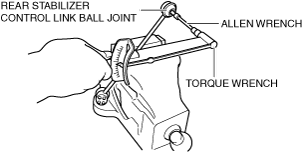 |
ac8wzw00001934
REAR STABILIZER CONTROL LINK INSPECTION
id021400800300
1. Remove the wheel and tire. (See WHEEL AND TIRE REMOVAL/INSTALLATION.)
2. Remove the rear stabilizer control link. (See REAR STABILIZER REMOVAL [2WD].) (See REAR STABILIZER INSTALLATION [2WD].) (See REAR STABILIZER REMOVAL [4WD].) (See REAR STABILIZER INSTALLATION [4WD].)
3. Inspect the rear stabilizer control link for bends or damage.
4. Rotate and shake the ball joint stud 10 times.
5. Measure the rear stabilizer control link ball joint rotational torque using an Allen wrench and a torque wrench.
ac8wzw00001934
|